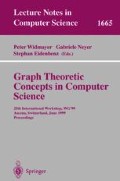Abstract
Knödel graphs and Fibonacci graphs are two classes of bipartite incident-graph of circulant digraphs. Both graphs have been extensively studied for the purpose of fast communications in networks, and they have deserved a lot of attention in this context. In this paper, we show that there exists an O(n log5 n)-time algorithm to recognize Knödel graphs, and that the same technique applies to Fibonacci graphs. The algorithm is based on a characterization of the cycles of length six in these graphs (bipartite incident-graphs of circulant digraphs always have cycles of length six). A consequence of our result is that none of the Knödel graphs are edge-transitive, apart those of 2 k -2 vertices. An open problem that arises in this field is to derive a polynomial-time algorithm for any infinite family of bipartite incident-graphs of circulant digraphs indexed by their number of vertices.
Additional support by the DRET of the DGA.
Additional support by the CNRS.
Access this chapter
Tax calculation will be finalised at checkout
Purchases are for personal use only
Preview
Unable to display preview. Download preview PDF.
References
A. Ádám. Research problem 2-10. J. Combin. Theory, 2:393, 1967. 217
B. Alspach and T. Parsons. Isomorphism of circulant graphs and digraphs. Discrete Mathematics, 25:97–108, 1979. 217
J-C. Bermond, F. Comellas, and F. Hsu. Distributed loop computer networks: a survey. Journal of Parallel and Distributed Computing, 24:2–10, 1995. 217
J. Cohen, P. Fraigniaud, and C. Gavoille. Recognizing bipartite incident-graphs of circulant digraphs. Technical report, Laboratoire de Recherche en Informatique, http://www.lri.fr/~pierre Univ. Paris-Sud, France, 1999. 224, 225
G. Cybenko, D.W. Krumme, and K.N. Venkataraman. Gossiping in minimum time. SIAM Journal on Computing, 21(1):111–139, 1992. 215, 216
B. Elspas and J. Turner. Graphs with circulant adjacency matrices. J. Comb. Theory, 9:229–240, 1970. 217
S. Even and B. Monien. On the number of rounds necessary to disseminate information. In First ACM Symposium on Parallel Algorithms and Architectures (SPAA), 1989. 215, 216
P. Fraigniaud and E. Lazard. Methods and Problems of Communication in Usual Networks. Discrete Applied Mathematics, 53:79–133, 1994. 215
S.M. Hedetniemi, S.T. Hedetniemi, and A. Liestman. A survey of gossiping and broadcasting in communication networks. Networks, 18:319–349, 1986. 215
M-C. Heydemann, N. Marlin, and S. Pïrennes. Cayley graphs with complete rotations. Technical Report 1155, LRI, Bât. 490, Univ. Paris-Sud, 91405 Orsay cedex, lFrance, 1997. Submitted to the European Journal of Combinatorics. 224, 225
J. Hromković, R. Klasing, B. Monien, and R. Peine. Dissemination of information in interconnection networks (broadcasting and gossiping). In Ding-Zhu Du and D. Frank Hsu, editors, Combinatorial Network Theory, pages 125–212. Kluwer Academic, 1995. 215
W. Knodel. New gossips and telephones. Discrete Mathematics, 13:95, 1975. 215, 216
R. Labahn and I. Warnke. Quick gossiping by telegraphs. Discrete Mathematics, 126:421–424, 1994. 215
B. Mans, F. Pappalardi, and I. Shparlinski. On the Ádám conjecture on circulant graphs. In Fourth Annual International Computing and Combinatorics Conference (Cocoon’ 98), Lecture Notes in Computer Science. Springer-Verlag, 1998. 217
M. Muzychuk and G. Tinhoffer. Recognizing circulant graphs of prime order in polynomial time. The electronic journal of combinatorics, 3, 1998. 217
A. Nayak, V. Accia, and P. Gissi. A note on isomorphic chordal rings. Information Processing Letters, 55:339–341, 1995. 217
I. Ponomarenko. Polynomial-time algorithms for recognizing and isomorphisn testing of cyclic tournaments. Acta Applicandae Mathematicae, 29:139–160, 1992. 217
V.S. Sunderam and P. Winkler. Fast information sharing in a distributed system. Discrete Applied Mathematics, 42:75–86, 1993. 215
Author information
Authors and Affiliations
Editor information
Editors and Affiliations
Rights and permissions
Copyright information
© 1999 Springer-Verlag Berlin Heidelberg
About this paper
Cite this paper
Cohen, J., Fraigniaud, P., Gavoille, C. (1999). Recognizing Bipartite Incident-Graphs of Circulant Digraphs. In: Widmayer, P., Neyer, G., Eidenbenz, S. (eds) Graph-Theoretic Concepts in Computer Science. WG 1999. Lecture Notes in Computer Science, vol 1665. Springer, Berlin, Heidelberg. https://doi.org/10.1007/3-540-46784-X_22
Download citation
DOI: https://doi.org/10.1007/3-540-46784-X_22
Publisher Name: Springer, Berlin, Heidelberg
Print ISBN: 978-3-540-66731-5
Online ISBN: 978-3-540-46784-7
eBook Packages: Springer Book Archive

